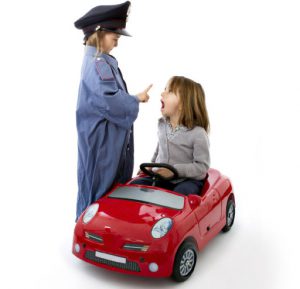Download a printable copy of this article (PDF 325KB)

- Punishment can work if you know the code.
- Punishment requires constant vigilance.
- Punishment can be exhausting.
- Select a small number of punishable rules.
- Foster behaviour that is the opposite to the punishable kind.
Most of you will have arrived at work today by car. That trip can be an event in itself. For some it’s bedlam, a manic period of dropping children off, fixing hair at the traffic lights because you didn’t get time between brushing the hair, teeth and attitudes of the little people in your homes. For others, it’s respite, a couple of quiet songs and a newsbreak before the mayhem of the school day begins.
Amidst the madness, is it remotely possible that your vehicle momentarily slipped above the speed limit? Think hard. For many of us the answer is a sheepish yes. Equally, there’s a very high likelihood that you were not caught and punished for your crime. You got away with it! And for this reason you are likely to make the occasional trip above the limit again in the future.
But what if your car were fitted with a device which transferred $200 from your account to the State Government every time you sped? Would this change your behaviour? The answer is probably a resounding yes this time around. We’d be so much more careful if we knew with absolute certainty that we would be caught every time we broke this well intended law.
This is the Punishment Code. For behaviour to change, ideally we need to be caught and punished every single time otherwise we may not be able to resist the compulsion to test the system occasionally. The good news is that the Punishment Code works. The bad news is that it’s utterly exhausting.
Think about AFL football for a moment. At its inception, there were only 10 one-sentence rules for play. There was no umpire, such was the ease with which the rules could be applied. Across the decades, dozens more rules, sub-sections and interpretations have been added. What is the result? There are now nine umpires controlling a top-level match, such is the
effort required to control the game. Those pesky players just keep trying to get away with stuff … unless we commit to catching them every single time.
There’s a lesson in this for schools. Rules are fine, and in fact part of the reason you didn’t crash on the way to work today was because of an intermittently enforced speed limit. But choose them wisely. If you are going to punish students for breaking rules, it is best to have a small number of them, or you’ll be completely drained of energy by the end of each day. You’re also risking doing little else than rule enforcement.
Think hard about your own needs in the learning environment. Identify two or three behaviours that you will not accept.
- Creatively foster and encourage the opposite of that behaviour.
- Explicitly state the behaviours that you are targeting and the rules attached.
- Make utterly clear what the consequences for breaching the rules are.
- Prepare for the boundaries to be tested.
Whatever the best laid plans and rules there’s always something within us that yearns to touch the park bench with the wet paint sign; to touch the stove even though we’ve been warned of its dangers; to walk across the road just a few metres from the zebra crossing.
Breaking rules and testing boundaries is a normal part of growing up. Forgive the breaching of your rules and have some faith that your students will eventually turn out fine just as you have … unless you plan on self-reporting the next time you creep over the speed limit.







